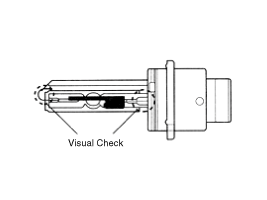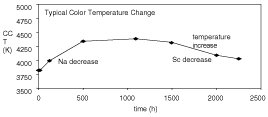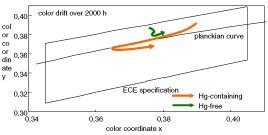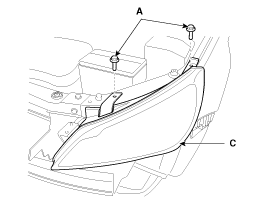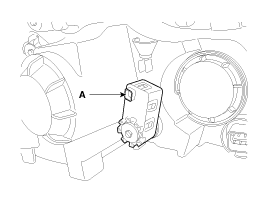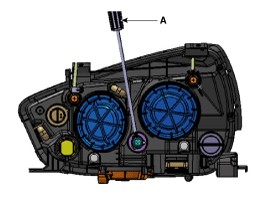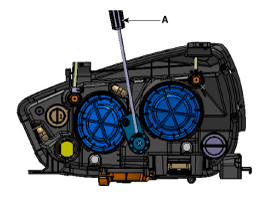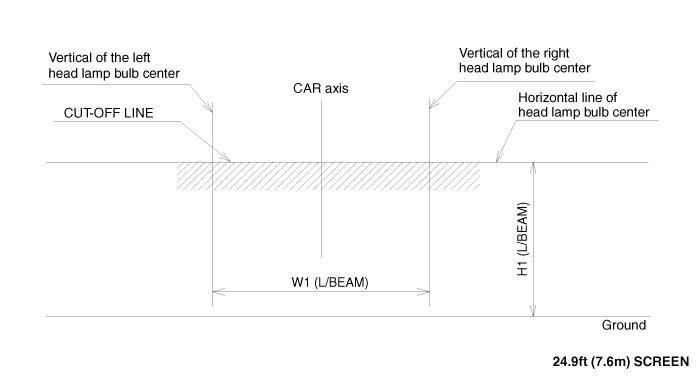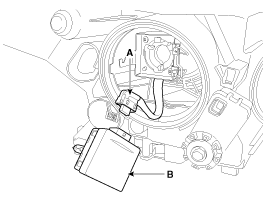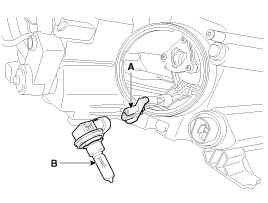Kia Cadenza: Lighting System / Head Lamps Repair procedures
Kia Cadenza YG 2016-2025 Service Manual / Body Electrical System / Lighting System / Head Lamps Repair procedures
| Inspection |
| 1. |
Check-points upon head lamp failure (HID)
|
| 2. |
Service procedure and warning (HID)
|
| 3. |
Understanding of color change by replacement of HID bulb.
|
Characteristic
| 1. |
Durable for vibration as there is no filament. |
| 2. |
HID lamp had a more long life than halogen lamp. |
| 3. |
Does not operate if polarity is changed. |
| 4. |
Operating input voltage : 9-16V |
| Removal |
| 1. |
Disconnect the negative (-) battery terminal. |
| 2. |
Remove the front bumper.
(Refer to Body - "Front Bumper") |
| 3. |
Loosening the head lamp mounting bolts (A) (4EA) and disconnect the head lamp connector (B).
Then, remove the head lamp assembly (C).
|
| 4. |
In case of HID type, disconnect the head lamp leveling actuator connector (A).
|
| 5. |
Remove the dust caps from the head lamp assembly after turning in the counter clock-wise direction.
A : Head Lamp (High) Cap
B : Head Lamp (Low) Cap
C : Turn Signal Lamp
|
| Installation |
| 1. |
Install the head lamp bulbs. |
| 2. |
Connect the connectors. |
| 3. |
Install the head lamp bolts (4EA) in alphabetical order. |
| 4. |
Connect the negative (-) battery terminal. |
| Head Lamp Aiming Instructions |
The head lamps should be aimed with the proper beam-setting
equipment, and in accordance with the equipment manufacturer''s
instructions.
If there are any regulations pertinent to the aiming of head
lamps in the area where the vehicle is to be used, adjust so as to meet
those requirements. |
Alternately turn the adjusting gear to adjust the head lamp
aiming. If beam-setting equipment is not available, proceed as follows:
| 1. |
Inflate the tires to the specified pressure and remove any loads from the vehicle except the driver, spare tire, and tools. |
| 2. |
The vehicle should be placed on a flat floor. |
| 3. |
Draw vertical lines (Vertical lines passing through
respective head lamp centers) and a horizontal line (Horizontal line
passing through center of head lamps) on the screen. |
| 4. |
With the head lamp and battery in normal condition, aim the
head lamps so the brightest portion falls on the horizontal and vertical
lines.
A : Vertical (Low/High)
[General type / HID + AFLS type]
[HID type]
|
Front Fog Lamp Aiming
The front fog lamps should be aimed as the same manner of the head lamps aiming.
With the front fog lamps and battery normal condition, aim the front fog lamps by turning the adjusting screw (A) with a driver.
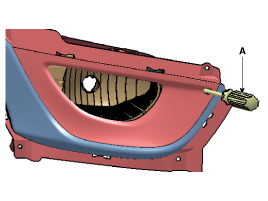
Head Lamp And Fog Lamp Aiming Point
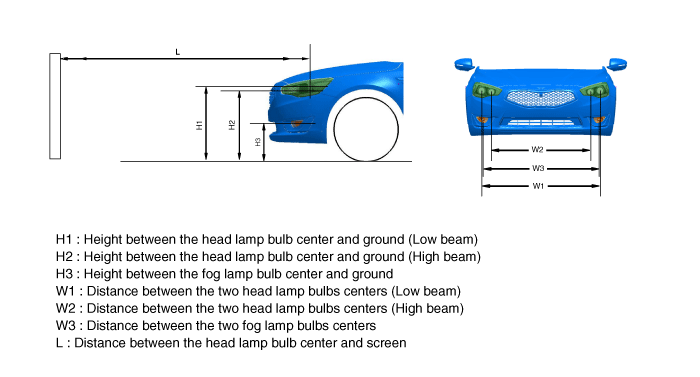
| Vehicle condition | H1 | H2 | H3 | W1 | W2 | W3 | L | ||
| BULB | LED | BULB | LED | ||||||
| Without driver | 28.3 (719) | 27.7 (703) | 14.4 (367) | 14.3 (365) | 57.2 (1,454) | 47.8 (1,213) | 56.2 (1,428) | 56.9 (1,446) | Refer to aiming condition |
| With driver | 28.0 (712) | 27.4 (696) | 14.2 (360) | 14.1 (358) | |||||
| 1. |
General Type (VOR)
|
| 2. |
Turn the front fog lamp on with driver seated in the vehicle.
The cut-off line should be projected in the allowable range shown in the picture.
|
| Replacement |
Head Lamp (Low)
| [General type] |
| 1. |
Turn the head lamp switch off. |
| 2. |
Disconnect the power connector from the lamp. |
| 3. |
Remove the head lamp (Low) cap. |
| 4. |
Disconnect the connector (A). |
| 5. |
Remove the blub (C) after releasing the fixing clip (B).
|
| 6. |
Installation is the reverse of removal. |
Head Lamp (Low)
| [HID type] |
| 1. |
Turn the head lamp switch off. |
| 2. |
Disconnect the power connector from the lamp. |
| 3. |
Remove the head lamp (Low) cap. |
| 4. |
Remove the fixed clip (A).
|
| 5. |
Remove the ignitor (B) after disconnecting the connector (A).
|
| 6. |
Installation is the reverse of removal.
|
Ballast
| 1. |
Turn the head lamp switch off. |
| 2. |
Remove the head lamp assembly. |
| 3. |
Disconnect the power connector from the lamp. |
| 4. |
Remove the ballast (A) after removing the screws.
|
| 5. |
Installation is the reverse of removal.
|
Head lamp(High) bulb
| 1. |
Turn the head lamp power off. |
| 2. |
Disconnect the power connector from the lamp. |
| 3. |
Remove the head lamp (High) cap. |
| 4. |
Turn the bulb (A) counter clockwise to remove the bulb.
|
| 5. |
Remove the head lamp (High) bulb (B) after removing the connector (A).
|
| 6. |
Installation is the reverse of removal. |
Turn Signal Lamp
| 1. |
Turn the head lamp power off. |
| 2. |
Turn the bulb socket (A) counterclockwise to remove the turn signal bulb.
|
 Head Lamps Description and Operation
Head Lamps Description and Operation
HID Head Lamp
1.
Bulb
(1)
Elements
Xenon gas: Xenon gas activates the initial reaction for rapid illuminating.
Molybdenum electrode: anode arcing
Metal halide salts: color composing component ...
 Room Lamp Repair procedures
Room Lamp Repair procedures
Inspection
Room Lamp
1.
Check that the switch operates properly after disconnecting the room lamp connector (A).
Removal
Room Lamp
1.
Disconnect the negative(-) battery terminal.
2.
Car ...
Other information:
Kia Cadenza YG 2016-2025 Owners Manual: Interior lights
Do not use the interior lights for extended periods when the engine is not running. It may cause battery discharge. WARNING - Interior Lights Do not use the interior lights when driving in the dark. Accidents could happen because the view may be obscured by interior lights. Automat ...
Kia Cadenza YG 2016-2025 Service Manual: Rear Stabilizer Bar Repair procedures
Replacement 1. Remove the rear wheel & tire. Tightening torque: 88.3 ~ 107.9N.m (9.0 ~ 11.0kgf.m, 65.1 ~ 79.6lb-ft) Be careful not to damage to the hub bolts when removing the rear wheel & tire. 2. Loosen the nut and then remove the rear stabiliz ...
Copyright © www.kcadenzavg.com 2017-2025



